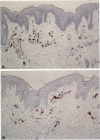Abstract
The mechanism(s) and the factor(s) that contribute to preferential localization of fixed drug eruption (FDE) lesions to certain skin sites remain speculative. Previous studies suggested that populations of T cells residing in the lesional epidermis may be involved in selective destruction of the epidermis in FDE. In this study, to define the earliest cellular and molecular events with potential relevance to activation of the epidermal T cells, expression of adhesion molecules on keratinocytes (KC) and vascular endothelium was examined sequentially in the lesional skin of FDE patients after challenge with the causative drug. Rapid and intense intercellular adhesion molecule-1 (ICAM-1) expression was induced on the vascular endothelium and KC as early as 1.5 hours after challenge, at which time E-selectin and vascular cell adhesion molecule-1 (VCAM-1) were not up-regulated. In vitro studies using skin organ culture showed that the lesional KC and endothelium responded more rapidly and intensely to express ICAM-1 to tumor necrosis factor-alpha or interferon-gamma compared with those in the nonlesional skin. Surprisingly, such selective induction of KC ICAM-1 restricted to the lesional skin was also observed after exposure to the causative drug alone in skin organ culture. Pretreatment of the lesional skin with anti-tumor necrosis factor completely abrogated in vitro induction of KC ICAM-1 expression by the drug. Drug-induced, TNF-alpha-dependent KC ICAM-1 expression in the lesional skin suggests that induction of ICAM-1 expression by the lesional KC after ingestion of the drug would probably provide a localized initiating stimulus for activation of the disease-associated epidermal T cells.
Full text
PDF










Images in this article
Selected References
These references are in PubMed. This may not be the complete list of references from this article.
- Barker J. N., Mitra R. S., Griffiths C. E., Dixit V. M., Nickoloff B. J. Keratinocytes as initiators of inflammation. Lancet. 1991 Jan 26;337(8735):211–214. doi: 10.1016/0140-6736(91)92168-2. [DOI] [PubMed] [Google Scholar]
- Cabañas C., Hogg N. Ligand intercellular adhesion molecule 1 has a necessary role in activation of integrin lymphocyte function-associated molecule 1. Proc Natl Acad Sci U S A. 1993 Jun 15;90(12):5838–5842. doi: 10.1073/pnas.90.12.5838. [DOI] [PMC free article] [PubMed] [Google Scholar]
- Dustin M. L., Rothlein R., Bhan A. K., Dinarello C. A., Springer T. A. Induction by IL 1 and interferon-gamma: tissue distribution, biochemistry, and function of a natural adherence molecule (ICAM-1). J Immunol. 1986 Jul 1;137(1):245–254. [PubMed] [Google Scholar]
- Gamble J. R., Khew-Goodall Y., Vadas M. A. Transforming growth factor-beta inhibits E-selectin expression on human endothelial cells. J Immunol. 1993 May 15;150(10):4494–4503. [PubMed] [Google Scholar]
- Gordon J. R., Galli S. J. Release of both preformed and newly synthesized tumor necrosis factor alpha (TNF-alpha)/cachectin by mouse mast cells stimulated via the Fc epsilon RI. A mechanism for the sustained action of mast cell-derived TNF-alpha during IgE-dependent biological responses. J Exp Med. 1991 Jul 1;174(1):103–107. doi: 10.1084/jem.174.1.103. [DOI] [PMC free article] [PubMed] [Google Scholar]
- Griffiths C. E., Nickoloff B. J. Keratinocyte intercellular adhesion molecule-1 (ICAM-1) expression precedes dermal T lymphocytic infiltration in allergic contact dermatitis (Rhus dermatitis). Am J Pathol. 1989 Dec;135(6):1045–1053. [PMC free article] [PubMed] [Google Scholar]
- Hindsén M., Christensen O. B., Gruic V., Löfberg H. Fixed drug eruption: an immunohistochemical investigation of the acute and healing phase. Br J Dermatol. 1987 Mar;116(3):351–360. doi: 10.1111/j.1365-2133.1987.tb05849.x. [DOI] [PubMed] [Google Scholar]
- Klein L. M., Lavker R. M., Matis W. L., Murphy G. F. Degranulation of human mast cells induces an endothelial antigen central to leukocyte adhesion. Proc Natl Acad Sci U S A. 1989 Nov;86(22):8972–8976. doi: 10.1073/pnas.86.22.8972. [DOI] [PMC free article] [PubMed] [Google Scholar]
- Leung D. Y., Pober J. S., Cotran R. S. Expression of endothelial-leukocyte adhesion molecule-1 in elicited late phase allergic reactions. J Clin Invest. 1991 May;87(5):1805–1809. doi: 10.1172/JCI115201. [DOI] [PMC free article] [PubMed] [Google Scholar]
- Nickoloff B. J., Mitra R. S., Green J., Zheng X. G., Shimizu Y., Thompson C., Turka L. A. Accessory cell function of keratinocytes for superantigens. Dependence on lymphocyte function-associated antigen-1/intercellular adhesion molecule-1 interaction. J Immunol. 1993 Mar 15;150(6):2148–2159. [PubMed] [Google Scholar]
- Rohde D., Schlüter-Wigger W., Mielke V., von den Driesch P., von Gaudecker B., Sterry W. Infiltration of both T cells and neutrophils in the skin is accompanied by the expression of endothelial leukocyte adhesion molecule-1 (ELAM-1): an immunohistochemical and ultrastructural study. J Invest Dermatol. 1992 May;98(5):794–799. doi: 10.1111/1523-1747.ep12499959. [DOI] [PubMed] [Google Scholar]
- Schwartz R. H. Costimulation of T lymphocytes: the role of CD28, CTLA-4, and B7/BB1 in interleukin-2 production and immunotherapy. Cell. 1992 Dec 24;71(7):1065–1068. doi: 10.1016/s0092-8674(05)80055-8. [DOI] [PubMed] [Google Scholar]
- Shiohara T., Moriya N., Tanaka Y., Arai Y., Hayakawa J., Chiba M., Nagashima M. Immunopathologic study of lichenoid skin diseases: correlation between HLA-DR-positive keratinocytes or Langerhans cells and epidermotropic T cells. J Am Acad Dermatol. 1988 Jan;18(1 Pt 1):67–74. doi: 10.1016/s0190-9622(88)70011-0. [DOI] [PubMed] [Google Scholar]
- Shiohara T., Nickoloff B. J., Sagawa Y., Gomi T., Nagashima M. Fixed drug eruption. Expression of epidermal keratinocyte intercellular adhesion molecule-1 (ICAM-1). Arch Dermatol. 1989 Oct;125(10):1371–1376. doi: 10.1001/archderm.125.10.1371. [DOI] [PubMed] [Google Scholar]
- Verwilghen J., Vandenberghe P., Wallays G., de Boer M., Anthony N., Panayi G. S., Ceuppens J. L. Simultaneous ligation of CD5 and CD28 on resting T lymphocytes induces T cell activation in the absence of T cell receptor/CD3 occupancy. J Immunol. 1993 Feb 1;150(3):835–846. [PubMed] [Google Scholar]
- Waldorf H. A., Walsh L. J., Schechter N. M., Murphy G. F. Early cellular events in evolving cutaneous delayed hypersensitivity in humans. Am J Pathol. 1991 Feb;138(2):477–486. [PMC free article] [PubMed] [Google Scholar]
- Walsh L. J., Trinchieri G., Waldorf H. A., Whitaker D., Murphy G. F. Human dermal mast cells contain and release tumor necrosis factor alpha, which induces endothelial leukocyte adhesion molecule 1. Proc Natl Acad Sci U S A. 1991 May 15;88(10):4220–4224. doi: 10.1073/pnas.88.10.4220. [DOI] [PMC free article] [PubMed] [Google Scholar]
- Wertheimer S. J., Myers C. L., Wallace R. W., Parks T. P. Intercellular adhesion molecule-1 gene expression in human endothelial cells. Differential regulation by tumor necrosis factor-alpha and phorbol myristate acetate. J Biol Chem. 1992 Jun 15;267(17):12030–12035. [PubMed] [Google Scholar]







